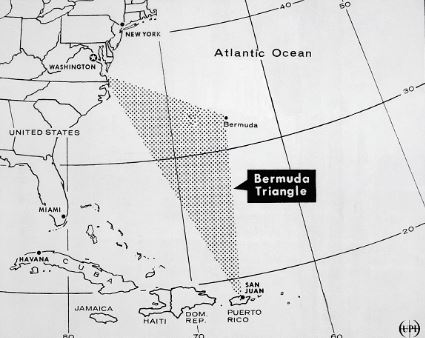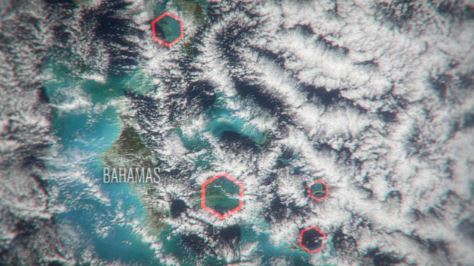4 Impending Panics From The Past (And What Came Of Them)

Every few years, there's a new scary thing that threatens to destroy our way of life. As the highly evolved creatures that we are, we take a moment to ponder the predicament and then scream "WE'RE ALL GONNA DIE!" as we loot appliance stores.
Once we've collectively overdosed on panic, we just move on like it never happened, never mentioning the problem again. Did it go away on its own? Did we solve it? Was it all a bunch of bullshit fearmongering perpetrated by an irresponsible media? Regardless of the answer to the first two questions, the answer to the third is always "Yes."
The Hole In The Ozone Layer
The ozone is a layer of the Earth's atmosphere that shields us from the Sun's homicidal tendencies. In 1985, British scientists announced to the world that there was a massive hole in it over Antarctica. Humanity collectively lost its mind. Suddenly, sunblock wasn't just a good idea; it was the only thing that was going to protect us from the Sun tearing the flesh from our bones with its bare hands. Highlander II: The Quickening and Escape From LA used it as the reason the earth is an overheated dystopian mess, and both of those movies are excellent resources for scientific knowledge.

If this was left unchecked, then in time, we would all be massive walking skin tumors with teeth sprouting from our arms. Seeds wouldn't even get the chance to turn into big, beautiful trees, because the second their sprouts broke the surface of the soil, they would scream for mercy as they burst into flames.
So What Happened To It?
We fixed it! Yet it's still around! And recently, the hole was the widest it had ever been!
All of that is true. While we weren't paying attention, the ozone layer was off repairing itself after it got a little push from us. Researchers determined that chlorofluorocarbons were responsible for the hole. Those were the chemicals used in air conditioners, refrigerators, and cans of aerosol spray, like the air freshener your party guests never use after taking a fragrant dump.

The Montreal Protocol of 1987 was a global agreement to end the use of CFCs by 1996. The world complied, and the hole's been shrinking ever since. Think of it like a scab -- your mom always told you not to pick at it or it'll never heal. Same principle applies, but with the atmospheric barrier that protects us from turning into the gross burnt French fry at the bottom of the takeout bag.
In 2014, researchers reported the first signs of recovery. Then in 2015, the hole widened to the biggest it had ever been. Its size fluctuates naturally, so that's nothing to worry about. It's still shrinking, and it's predicted that it will be fully healed by mid-century. So if you have some kids right now, they might die right around the time an invisible hole in the sky patches itself up. What a wonderful world.
The Bermuda Triangle
Is it an alien hot spot? Is it home to the underwater city of Atlantis? The birthplace of a colony of sea Draculas who feed on the blood of shipwrecked survivors? For over a century, no one was able to explain the dozens of mysterious shipwrecks and plane crashes in the fabled Bermuda Triangle, a patch of the Atlantic Ocean between Miami, Bermuda, and Puerto Rico. And in the grand spectrum of our theories about it, sea Draculas was on the more logical end.

Fear of the triangle didn't kick into high gear until 1945, when 135 people went missing after five American bomber jets and a search-and-rescue plane went missing 141 miles east of Fort Lauderdale, Florida. We've been shitting our pants ever since. Throughout the 1960s and '70s, there were TV movies, dozens of fiction and nonfiction books, TV shows, and way too many documentaries telling the Triangle's tale, and every one of them ended with what amounts to an admission that nobody knows how, why, or what the fuck is going on.
The Bermuda Triangle has been eerily silent in recent years, and so have we on the subject. Did the recession force the Atlanteans to move to an underwater metropolis with more job opportunity? Did the aliens fly home after hitting their abduction quota? Did the sea Draculas explode after exposure to the tropical Sun, which was only made harsher by THE HOLE IN THE OZONE LAYER? OH MY GOD, I AM THE ILLUMINATI.
So What Happened To It?
We know that the number of disappearances within the Bermuda Triangle is no greater than any other high-traffic segment of ocean. But that still leaves the question of why ships and planes go down in that area at all. And for a brief moment in October 2016, we thought we had a definitive answer.
The Science Channel ran an interview with meteorological expert Randall Cerveny. When he said the root cause of the Bermuda Triangle's disappearances were hexagonal cloud formations that caused 125 mph wind bursts that could pulverize anything that got in their way, people took it seriously. For about a day. One of the first people to call bullshit was Randall himself.

The talking heads on this particular show he was on came armed with two explanations for the phenomena they were talking about for that day: 1) the most plausible answer, and 2) the one that's fun but less plausible, or flat-out dumb. Randall gave the implausible explanation, and the producers used it as the plausible one. What he was describing were microbursts -- extremely powerful bursts of wind that target a small area. They can take down a ship, but they don't solve the riddle of the Bermuda Triangle. But once Randall cleared the air about that, we were all left with no other choice but to go right back to aliens, Atlantis, and sea Draculas.
Pit Bull Bans
America didn't have a problem with pit bulls until people started using them to guard things. Pit bulls look like club bouncers, and can be vicious protectors if trained to be, and that's why they were the dog of choice for city dwellers trying to protect their homes or businesses in areas with high crime rates.

Soon, there were rumors of underground pit bull fighting rings cropping up all across America. The media latched on and perpetuated. The breed that was once well-known as the Little Rascals' adorable animal companion was now made to look like Cerberus holding a machine gun. Rumor of a pit bull's bite applying many thousands of pounds of pressure, enough to turn bones to dust, spread far and wide. Every report of a pit bull attack over the years amplified the public perception of the animal as inherently bloodthirsty. Pit bulls were going to kill you, injure your spouse, and make fun of your son's haircut.
Local governments across America drafted legislation banning pit bulls, with bills passing in both tiny towns in the middle of nowhere and major cities like Miami. More than 900 cities in the United States have passed some kind of breed-specific legislation banning or curtailing the ownership of pit bulls.
So What Happened To It?
Pit bulls are still banned in cities across America, but the bans are often overturned.
In the panic to protect citizens from the menace of man-eating pit bulls, local governments hastily throw together legislation banning the breed, even though there's no data that proves the need.

In 2014, the American Veterinary Medical Association released the findings of a study which determined that a dog's breed is a real shitty way to predict if it'll bite. A different study found that pit bulls were no more aggressive than any other dog, and that Chihuahuas were by far a much more aggressive breed, but no one gives a shit about them because they can be punted into the Sun if they act up. Plenty of major organizations, including the U.S. Justice Department and the American Bar Association, deem pit bull bans useless and see no truth in the animal's bad reputation.
Acid Rain
Throughout the 1980s and early 1990s, a sizable media panic was caused by two words that when paired sound like a weather condition in Hell: acid rain. Sulfur dioxide and nitrogen oxides released by burning fossil fuels (mostly from coal-burning power plants) caused storms that rained acidic compounds onto lakes, streams, oceans, soil, and your kids, burning everything it touched with a snake-like hiss that melted people down to puddles of screaming bubbly goo.
It didn't actually do any of that. But it was blamed for the formation of sinkholes in Florida, people thought it would ruin crops, and some feared that it would kill fish, including (gasp!) the ones we like to eat. As an elementary school student in the early '90s, I remember a light rain falling in the middle of my PE class. However, we treated this like a torrent of droplets with grenades in them after some idiot yelled "ACIDDDDD RAAAINNNNN!" and sent us all in a blind rush to find cover.
The world isn't badass enough to produce grenade rain, but a lot of acid rain's effects were real. But by the mid-'90s, fear and nearly all mention of acid rain had disappeared.
So What Happened To It?
This may sound like an astounding feat of superheroic proportions, but in 1990, Congress and President George H.W. Bush listened to the concerns voiced by scientists and actually addressed the problem by amending the Clean Air Act of 1963 to include a plan to fight acid rain before it did any real damage.

The Acid Rain Program was an earlier version of Cap and Trade. Companies had a numerical limit to how much SO2 they could release a year. However they did it was entirely up to them. So let's say you're a major company that burns tons of fossil fuels. You're allowed to emit five pollutions a year. You can emit all five if you want, but if you were a smart company that was able to reduce emissions through innovation, you can sell the unused cap to dumber companies that have yet to develop enough empathy to care that the byproduct of their work poisons people. You just helped save the world by innovating in a way that other companies can emulate and made money off of, too.
And it worked. 26 million tons of SO2 were emitted by the United States in 1980. The goal was to reduce that by 10 million by 2000, 10 years after the regulation was signed into law. By the time Bush's son became president, emissions had been reduced by 8.95 million tons, just falling short of the goal but still making a hell of a difference. A 2003 government study said the Acid Rain Program resulted in the "largest quantified human health benefits of any major federal regulatory program implemented in the last 10 years, with benefits exceeding costs by more than 40:1."

So the reason you don't hear about acid rain anymore is that many moons ago, in an age of wonder and bravery, a time that has now fallen into myth, Republicans actually gave a shit about the environment and didn't mind telling corporations that they needed to chill with the destructive greedy shit.
Luis is sipping a saucer of blood beneath the waves off of Miami's coast with a pit bull, Pitbull, and sea Draculas. In the meantime, you can find him on Twitter, Tumblr, and Facebook.
For more, check out The 6 Most Insane Moral Panics in American History and 6 New Kinds of Anxiety the Internet Gave Us.
Subscribe to our YouTube channel, and check out How Fallout Proves Morality Is Arbitrary, and watch other videos you won't see on the site!
Also follow us on Facebook. We're good, wholesome fun.